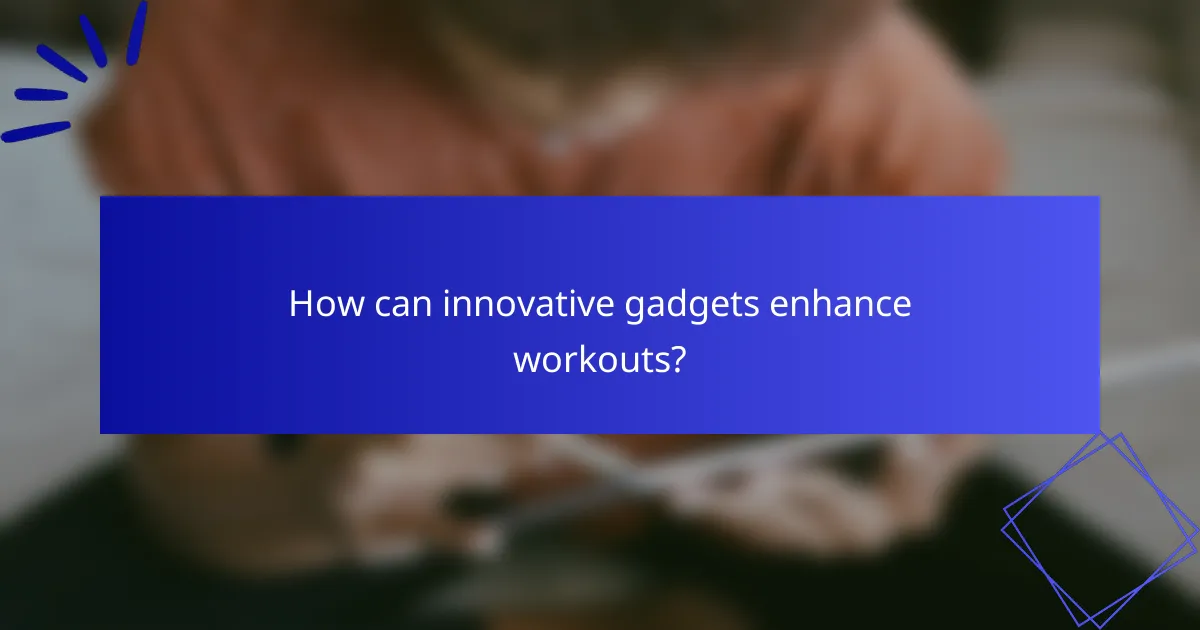Innovative gadgets are revolutionizing the way we approach fitness by enhancing workouts through real-time data, performance tracking, and motivation. These devices not only monitor vital metrics like heart rate and calories burned but also create an engaging and personalized exercise experience, helping users stay committed to their fitness goals.

How can innovative gadgets enhance workouts?
Innovative gadgets can significantly enhance workouts by providing real-time data, improving performance tracking, and boosting motivation. These devices help users monitor their progress, optimize their routines, and stay engaged in their fitness journey.
Smart fitness trackers
Smart fitness trackers are wearable devices that monitor various physical activities, including steps taken, calories burned, and sleep patterns. They often connect to mobile apps, allowing users to analyze their performance over time and set personalized fitness goals.
When choosing a fitness tracker, consider battery life, water resistance, and compatibility with other devices. Popular options include the Fitbit Charge and Garmin Vivosmart, which offer features like heart rate monitoring and GPS tracking.
Wearable heart rate monitors
Wearable heart rate monitors provide accurate heart rate readings during workouts, helping users maintain optimal intensity levels. These devices can be worn on the wrist, chest, or even as earbuds, offering flexibility and comfort.
To maximize their effectiveness, select a monitor that syncs with your fitness apps and provides real-time feedback. Look for options like the Polar H10 or Wahoo TICKR, which are known for their accuracy and reliability.
Smart gym equipment
Smart gym equipment, such as connected treadmills and stationary bikes, offers interactive workouts and performance tracking. These machines often come with built-in screens that provide access to virtual classes and personalized training programs.
When investing in smart gym equipment, consider factors like space, budget, and the variety of workouts offered. Brands like Peloton and NordicTrack are popular for their engaging platforms and community features.
Virtual reality fitness systems
Virtual reality (VR) fitness systems create immersive workout experiences that can make exercising more enjoyable. These systems often include games and challenges that require physical movement, turning workouts into engaging activities.
To get started with VR fitness, invest in a compatible headset and explore platforms like Oculus Quest or HTC Vive. Ensure you have enough space for movement and consider safety measures to avoid injuries during workouts.
AI-powered personal trainers
AI-powered personal trainers use algorithms to create customized workout plans based on individual fitness levels and goals. These virtual trainers can provide real-time feedback and adjust routines as users progress.
When selecting an AI trainer, look for apps that offer a variety of workouts and track your progress effectively. Popular options include Freeletics and Fitbod, which cater to different fitness preferences and levels.
![]()
What are the best performance tracking devices?
The best performance tracking devices offer a combination of accurate data collection, user-friendly interfaces, and features tailored to enhance workouts. These devices help monitor metrics like heart rate, distance, and calories burned, providing insights that can improve fitness routines.
Garmin Forerunner series
The Garmin Forerunner series is renowned for its GPS accuracy and extensive tracking capabilities, making it ideal for runners and cyclists. Models like the Forerunner 245 and 945 provide advanced metrics, including VO2 max and training load, which help users optimize their performance.
Consider battery life when choosing a model, as it can range from several days to weeks depending on usage. The Forerunner series also integrates with Garmin Connect, allowing users to analyze their data and share achievements with a community.
Fitbit Charge 5
The Fitbit Charge 5 combines fitness tracking with health monitoring features, such as stress management and sleep tracking. Its built-in GPS allows for accurate distance tracking during outdoor activities, while the heart rate monitor provides real-time feedback on workout intensity.
This device is particularly user-friendly, with a vibrant display and an intuitive app that offers personalized insights. Keep in mind that while it excels in daily activity tracking, it may not have the same depth of data analysis as some higher-end models.
Apple Watch Series 8
The Apple Watch Series 8 is a versatile smartwatch that doubles as a powerful fitness tracker. It features advanced health sensors, including an ECG app and blood oxygen monitoring, along with comprehensive workout tracking across various activities.
Its seamless integration with the iOS ecosystem allows users to receive notifications and access apps directly from their wrist. However, battery life is typically around 18 hours, so regular charging is necessary to keep it functional throughout the day.
Polar Vantage V2
The Polar Vantage V2 is designed for serious athletes, offering detailed performance metrics and training insights. It includes features like running power measurement and recovery tracking, which are essential for optimizing training plans.
This device is particularly beneficial for endurance athletes, as it provides personalized training recommendations based on individual performance data. Its robust battery life can last up to a week, making it suitable for long training sessions or races without the need for frequent recharging.

How do these gadgets motivate users?
Innovative workout gadgets motivate users by incorporating engaging features that enhance the exercise experience. They leverage technology to create a more interactive, social, and personalized environment, encouraging users to stay committed to their fitness goals.
Gamification features
Gamification features transform workouts into competitive games, making exercise more enjoyable. Users can earn points, unlock achievements, and compete against friends or global leaderboards, which adds a fun element to their fitness routine.
For example, fitness apps often include challenges that reward users for completing specific tasks, such as running a certain distance or achieving a personal best. This can significantly boost motivation and adherence to workout plans.
Social sharing capabilities
Social sharing capabilities allow users to connect with friends and share their fitness achievements on platforms like Facebook or Instagram. This not only fosters a sense of community but also encourages accountability, as users are more likely to stick to their goals when they share progress publicly.
Many gadgets and apps offer integrated sharing options, enabling users to post updates, photos, or workout summaries effortlessly. This social interaction can serve as a powerful motivator, inspiring others and receiving encouragement in return.
Personalized workout plans
Personalized workout plans tailor fitness routines to individual preferences, goals, and fitness levels. By analyzing user data, these gadgets can create customized programs that adapt over time, ensuring workouts remain challenging and effective.
For instance, a fitness tracker might suggest adjustments based on performance metrics, such as heart rate or calories burned. This level of personalization helps users stay engaged and motivated, as they can see tangible progress toward their specific fitness objectives.

What criteria should be considered when choosing workout gadgets?
When selecting workout gadgets, consider factors like compatibility with existing devices, battery life, durability, and overall value for money. These criteria ensure that the gadgets enhance your workout experience without causing frustration or additional costs.
Compatibility with existing devices
Ensure that your chosen workout gadgets can seamlessly integrate with your current devices, such as smartphones, fitness trackers, or smartwatches. Compatibility allows for easier data sharing and a more cohesive workout experience.
Check for support with popular fitness apps and platforms, as this can enhance functionality. For example, a heart rate monitor that syncs with your smartphone can provide real-time feedback and performance tracking.
Battery life and durability
Battery life is crucial for workout gadgets, especially if you engage in long training sessions. Look for devices that offer a minimum of several hours of active use, ideally extending to multiple days on standby.
Durability is equally important; choose gadgets that are water-resistant or sweat-proof to withstand rigorous workouts. For instance, a fitness tracker designed for outdoor use should be rugged enough to handle various weather conditions.
Price and value for money
Evaluate the price of workout gadgets in relation to their features and benefits. A higher price does not always guarantee better performance; consider what features are essential for your workout routine.
Look for gadgets that offer a good balance of quality and affordability. For example, a mid-range fitness tracker with essential features may provide better value than a high-end model with unnecessary extras. Always read reviews and compare options before making a purchase.

What are the latest trends in workout enhancement technology?
The latest trends in workout enhancement technology focus on integrating advanced tools that improve performance, track health metrics, and boost motivation. These innovations include smart home device integration, augmented reality experiences, and wearable health sensors that collectively transform how individuals engage with fitness routines.
Integration with smart home devices
Smart home devices are increasingly being integrated into workout routines to create a more personalized and efficient fitness environment. For example, smart speakers can provide real-time feedback during workouts, while smart lighting can adjust to set the mood for different types of exercises.
Consider using devices like smart thermostats to maintain optimal workout temperatures or smart mirrors that offer virtual coaching and performance tracking. This integration not only enhances the workout experience but also encourages consistency and motivation.
Augmented reality fitness experiences
Augmented reality (AR) fitness experiences are gaining popularity by merging physical workouts with digital enhancements. These applications can overlay virtual elements onto the real world, making exercises more engaging and interactive. For instance, AR can create immersive environments for running or cycling, simulating various terrains and challenges.
When exploring AR fitness options, look for apps that offer gamified workouts or virtual competitions with friends. This can significantly increase motivation and make exercising more enjoyable, especially for those who find traditional workouts monotonous.
Wearable health sensors
Wearable health sensors are at the forefront of fitness technology, providing real-time data on various health metrics such as heart rate, calories burned, and sleep quality. Devices like smartwatches and fitness trackers can help users monitor their progress and adjust their routines accordingly.
When choosing wearable sensors, consider factors like battery life, accuracy, and compatibility with other devices. Many wearables now offer features such as stress monitoring and guided breathing exercises, which can enhance overall well-being and performance.






